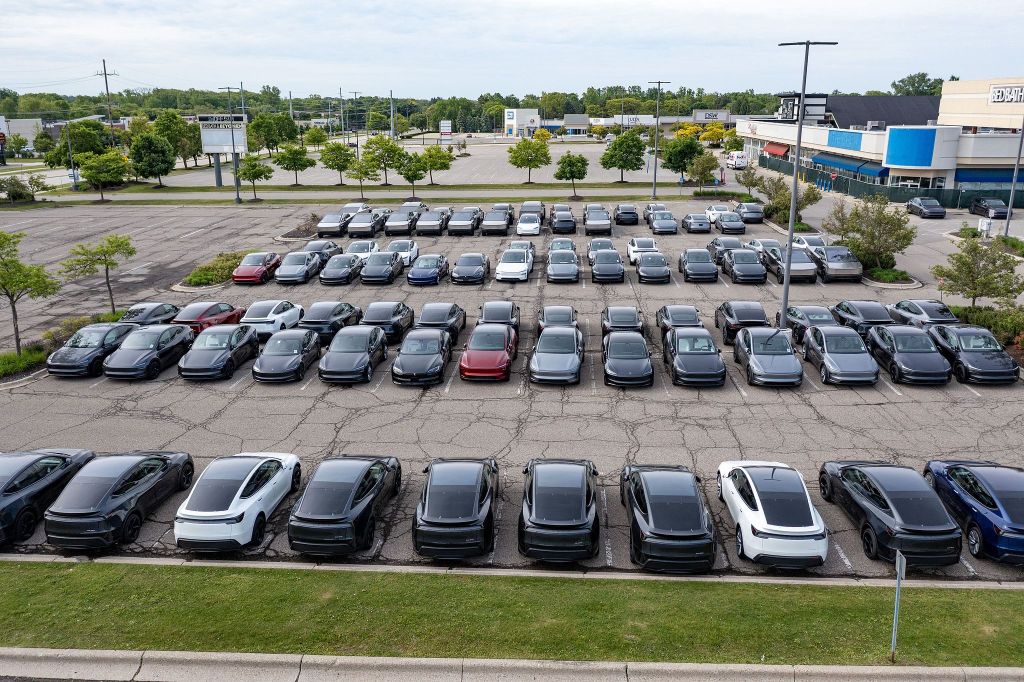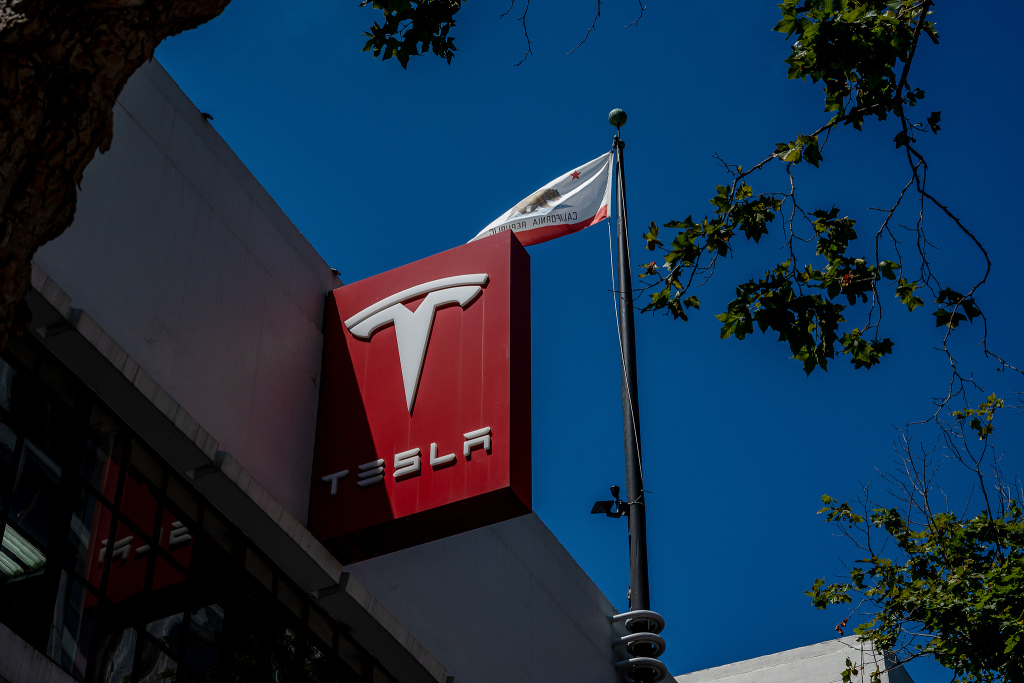
The U.S. auto industry has long relied heavily on federal support to keep its electric vehicle business afloat, but that support will come to an abrupt end on July 4th when President Trump signs the "big, beautiful" budget into law.
U.S. electric vehicle sales are likely to surge in the coming weeks as buyers rush to take advantage of a tax credit deadline. But the surge will be short-lived, leaving automakers facing difficult decisions.

Many unsold electric vehicles are seen in Farmington Hills, Michigan, on May 30, 2025, local time.
A $7,500 federal tax credit for electric vehicles expires on September 30. Trump's budget bill also ends the Zero Emission Vehicle Credit program, which funnels money from gasoline car makers to electric vehicle makers, and repeals penalties for companies that fail to meet Corporate Average Fuel Economy (CAFE) standards.
Over the years, these policies have fueled the growth of Tesla and electric vehicle startups and prompted auto giants such as Ford and General Motors to reshape themselves around electric vehicle-centric strategies.
The US electric vehicle market is shrouded in uncertainty due to trade tariffs and the end of incentives through 2026. Analysts haven't yet provided specific forward-looking EV sales forecasts, but most believe US EV demand will slow significantly over the coming year. Many automakers have already scaled back their US EV production plans over the past year due to cooling consumer demand. Now, they are preparing to scale back further or shift their focus to hybrid vehicles.
As the global trend shifts toward electrification, the U.S. auto industry could be left behind. China and Europe continue to lead the rapid adoption of electric vehicles. Chinese electric vehicles, which dominate the domestic market, are rapidly gaining traction abroad, setting new standards in quality, technology, and affordability.
Meanwhile, gasoline-electric hybrids are attracting more U.S. buyers, largely due to lower prices but also due to "range anxiety" and other consumer concerns. U.S. automakers may not completely turn away from the electric vehicle market, but the near-term outlook is difficult.
As Trump signed the new bill, the automaker sector as a whole has fallen 23% year-to-date.
Ford believes consumers still want electric vehicles. They just want them to be more affordable. Ford CEO Jim Farley said the company has focused significant resources on building "a breakthrough electric vehicle and a platform" in the United States.
Ford: The canary in the coal mine for electric vehicles
In August, Ford announced a new "common electric vehicle platform" and plans to release a mid-size electric pickup truck with a starting price of $30,000 in 2027.
Jim Farley said Ford had been working on the project for three years and it "represents the most radical change in the way we design and build cars at Ford since the Model T."
The event didn't reveal a new design, but it did provide some details. Jim Farley said the car will be incredibly spacious, have a front trunk and a "full" pickup truck bed, and will be faster than the twin-turbocharged Ford Mustang.
He also said the truck could power a home for up to six days, pledging the company's focus on producing affordable, profitable, mass-market electric vehicles.
"This is a 'Model T moment' for us at Ford," Jim Farley said on the company's recent second-quarter earnings call. Henry Ford's 1908 Model T, whose mass production innovations cut car prices by 60%, is considered the birth of the modern auto industry.
However, analysts remain skeptical. In its second-quarter earnings report, Ford said its electric vehicle division lost $1.33 billion in the second quarter, even though its electric vehicle revenue soared 105% year-on-year to $2.4 billion.
Morgan Stanley's Adam Jonas believes that now is "electric vehicle decision time" for Ford. The company appears to be the "canary in the Kentucky coal mine" when it comes to electric vehicles. However, "investors remain skeptical about how Ford can operate a profitable electric vehicle business in a market where even Tesla's automotive business is unprofitable," Jonas said.
Besides the reversal in consumer preferences and government policies, Jonas sees another looming threat: the “accelerated migration of Chinese electric vehicle technology to America’s shores.”
The era of policy incentives for electric vehicles in the United States ends
China's lead in electric vehicles is a recent phenomenon. Previously, Tesla was the industry benchmark. American and other automakers have been redoubling their efforts to catch up to Musk's first-mover advantage, believing that a full-scale investment in electric vehicles will boost stock prices.
Just five years ago, Mercedes and Volvo said they would go all-electric by 2030; GM's goal was 2035; Volvo acquired electric car maker Polestar as early as 2015; and Volkswagen decided last year to invest $5 billion in a joint venture with US electric car startup Rivian.
Underpinning these promises is a combination of subsidies and regulations from governments around the world. The United States leapt to the forefront of the electrification club when then-President Joe Biden signed several measures into law to promote renewable energy and incentivize electric vehicle production. The most effective for consumers is a tax credit of up to $7,500 under the 2022 Inflation Reduction Act (IRA).
In addition to IRA tax credits, zero-emission vehicle credits and corporate average fuel economy (CAFE) penalties also play a role. Tesla has long been a major beneficiary of the credit program and CAFE rules. This is because automakers that fail to meet federal emissions requirements typically purchase credits from the electric car giant or other companies with excess credits.
The programs also provide incentives for traditional automakers to switch to electric vehicles. Tesla earned $2.8 billion in revenue from selling credits in 2024, accounting for 16% of its gross profit.
U.S. electric vehicle sales surged 49% to a record 1.2 million in 2023. Stephanie Valdez-Strati, a senior analyst at Cox Automotive, said the IRA tax credit "really is an effective tool to help sales and achieve price parity between electric vehicles and gasoline-powered vehicles."
But sales quickly slow to 8% growth in 2024, or 1.3 million new electric vehicles.
The slowdown has continued this year. Electric vehicle sales in the United States fell 6.3% in the second quarter. This resulted in a mere 1.5% increase in electric vehicle sales to 607,089 units in the first half of 2025, according to Cox Automotive. Meanwhile, China sold more than 3 million electric vehicles in the first six months of 2025, with export sales accelerating.
"The year-over-year decline in the second quarter was only the third on record," said Strati. She believes this could be a sign of a "more mature market."
But it also shows consumer dissatisfaction with the high prices of electric vehicles. And, after the tax credit expires, it's hard to consider this very uncertain market mature. Strati believes the looming end of the IRA tax credit could trigger "record" U.S. electric vehicle sales by the third quarter, but then a "collapse" in the fourth quarter as "the electric vehicle market adjusts to its new reality."
"The second half of the year will be a key test for demand for electric vehicles," Strati said.
That's not necessarily a bad thing, said Stephanie Brinley, associate director of AutoIntelligence at S&P Global Mobility. Eliminating tax credits and other incentives allows demand to grow "more organically" and "less forced," Brinley said.
Overall, analysts predict a significant slowdown in the U.S. transition to electric mobility. Rhodium Group estimates that Trump’s budget proposal could mean there will be significantly fewer electric vehicles on the road by 2035 than previously forecast.
US electric vehicle market landscape
Electric vehicles currently account for only a small portion of car sales in the United States.
According to data compiled by Morgan Stanley, as of June, the Tesla Model Y was the best-selling pure electric vehicle in the United States this year, followed by the Tesla Model 3. General Motors' Chevrolet Equinox was a distant third. The Ford Mustang Mach-E and Hyundai Ioniq 5 rounded out the top five BEV models.
Cox Automotive forecast electric vehicle sales would account for about 10% of all new vehicle sales by 2025. Trump's policy changes have lowered that forecast to about 8.5%.
In China, total sales of new energy vehicles reached 5.47 million in the first half of 2025. According to the China Passenger Car Association, the penetration rate has exceeded 50%.
The United States also lags behind the European Union, where pure electric vehicles had a 15.6% market share in the first half of this year, up from 12.5% in the same period last year, according to the European Automobile Manufacturers Association.
In fact, even before Trump's new budget, automakers other than Tesla were already losing money on electric vehicles in the U.S. Many companies are canceling or delaying electric vehicle launches. Demand for electric vehicles appears to be softening, or at least recalibrating.
Ford, Mercedes, and Volvo all axed some electric vehicle models last year. Reports surfaced in July that Honda had shelved its planned 2026 launch of five- and seven-seat electric SUVs, shifting its focus to hybrid production.
Meanwhile, Nissan canceled plans for a future electric sedan in April after Nissan North America CEO Christian Meunier revealed the automaker was "listening to market data" that showed U.S. consumers were showing less demand for electric vehicles and more for SUVs.
Rising demand for hybrid models is key to this shift, Strati said. "So we may start to see more production shifting toward other alternative powertrains."
But that's not all. Ford said it will stick to its electric vehicle strategy, targeting both electric vehicle production and the release of new affordable models, despite delaying some new electric vehicle models until 2028.
Hyundai Motor is also significantly increasing electric vehicle production at its $7.6 billion Georgia plant, which is designed to produce 500,000 electric and hybrid vehicles annually. Currently, the plant produces the Ioniq 5 and Ioniq 9, but is expected to expand to produce other electric models from Hyundai, Kia, and Genesis.
Searching for an "affordable" electric car
General Motors is backing off its internal goal of ending sales of nearly all gasoline-powered vehicles by 2035. Chief Executive Mary Barra emphasized on a July 22 earnings call that GM now seeks to "flexibly switch based on market demand" between traditional internal combustion engine vehicles and electric vehicles.
GM's Chevrolet Equinox EV starts at around $35,000. The company is relaunching the improved Chevrolet Bolt EV, which could be released in early 2026. GM hasn't confirmed pricing yet, but it's expected to be around $30,000. The vehicle will feature GM's first lithium iron phosphate battery pack.
Barra said the focus is on "achieving profitability and then continuing to improve so that we can also achieve appropriate and strong profit margins on our electric vehicles." She believes this will put GM "in a very good position in the late 2020s and into the 2030s."
Tesla also continues to say it will soon release an affordable car. However, executives said on a July 23 earnings call that deliveries won't begin until at least the fourth quarter, after the $7,500 tax credit expires.
The actual impact of U.S. trade tariffs has yet to be determined. But they will undoubtedly increase production costs as automakers strive to develop and launch more affordable electric vehicles. Ford expects to be hit by $2 billion in tariffs this year, while Trump's tariffs cost General Motors $1.1 billion in the second quarter alone.
Under tariffs, building an affordable electric car could become even more expensive. On August 5, Cox Corporation boldly predicted that due to Trump's tariff policy, American consumers will see a 4% to 8% increase in car prices by the end of 2025, and price increases will accelerate as 2026 models enter the market.


